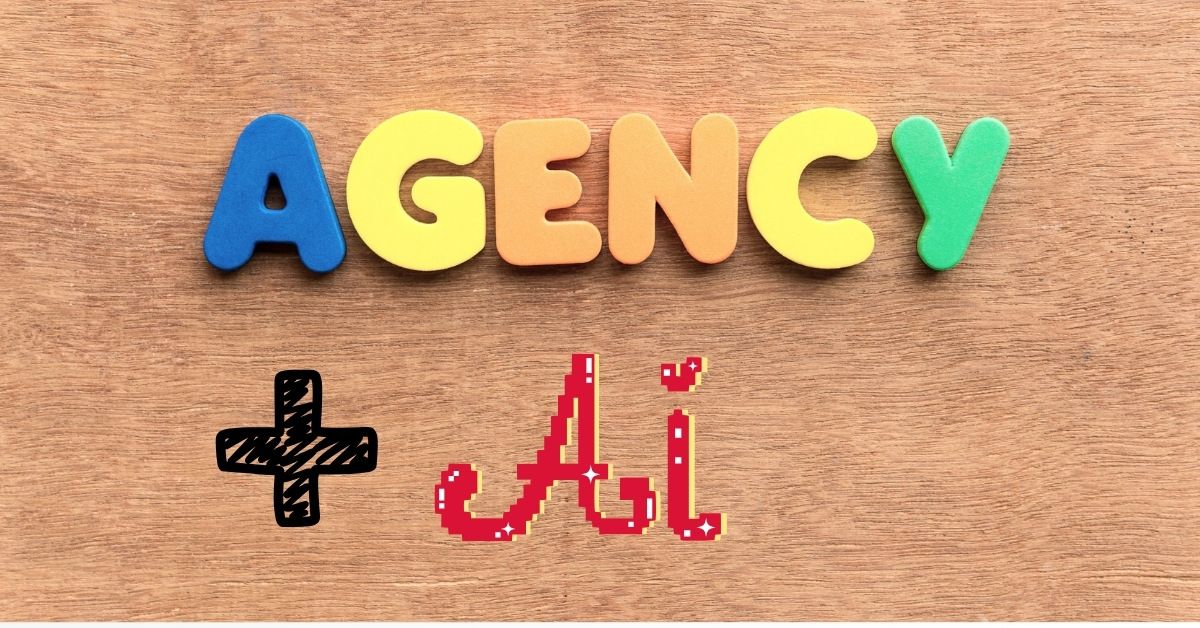AI Tools for agencies are not a future issue to be aware of, but a present one. Remember when agencies could dazzle clients just by showing up with a clever campaign and a killer pitch deck? Those days are gone. Now, clients expect more—faster timelines, deeper insights, and proof of results. If you’re running an agency, you’ve probably felt that pressure in your bones.
But here’s the upside: AI isn’t just a fancy buzzword anymore. It’s become the ultimate lever—something that lets nimble teams do the work of giants, and helps big shops move at startup speed. By 2025, more than 80% of businesses will have some form of AI automation baked into their workflows. If you want to keep up—or better yet, pull ahead—now’s the moment to evolve.
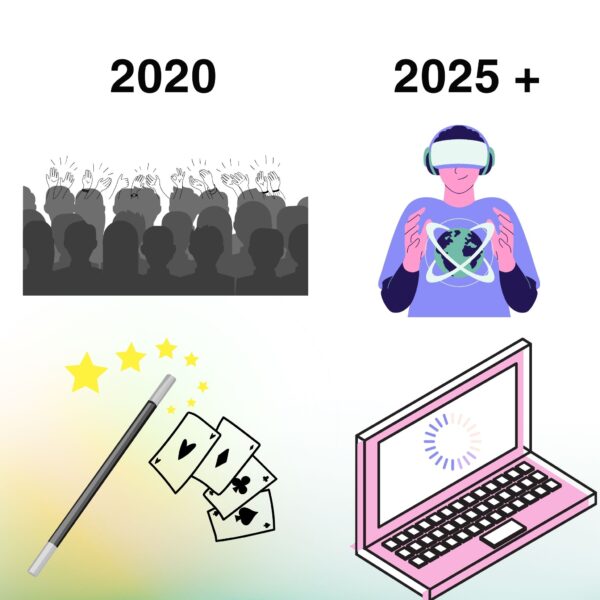
Why Agencies Must Evolve in the AI Era
Let me paint you a familiar picture: Your team is swamped with manual reporting, data wrangling, and endless project tweaks. Meanwhile, your client is getting emails from a competitor who turned over a full campaign analysis overnight—thanks to AI.
What’s really at risk isn’t jobs or creativity—it’s relevance. Agencies stuck in old habits are already losing ground because they can’t deliver the speed, scale, or personalization that AI enables and modern clients crave. On the flip side, AI is helping smaller agencies leapfrog established competitors by automating grunt work and freeing up their teams for the kind of creative and strategic thinking that actually moves the needle.
And this isn’t just hype. The Box’s State of AI in the Enterprise report shows that AI is quickly becoming the backbone of business productivity—and early movers are already seeing the payoff. AI agents are popping up across every corner of the workplace, shifting how agencies deliver value and collaborate. As these tools multiply, agencies that embrace them gain flexibility and boost their ROI, while those who wait risk getting left behind. Of course, this new era also demands a new level of responsibility: data security and digital trust are now just as important as speed and innovation.
Here’s what this looks like on the ground. According to a recent BCG article:
“One company used Generative AI to develop marketing content, leading to a 20–30% reduction in agency costs. An unbranded website article that previously cost over $20,000 became nearly free, and localization time for marketing assets was reduced from two months to one day, projecting savings of $80–170 million.”
Bottom line:
Being “AI-first” isn’t just a catchphrase—it’s the difference between thriving and falling behind. It’s like switching from a horse-drawn carriage to a bullet train: if you don’t get on board, you’ll watch the future speed by.
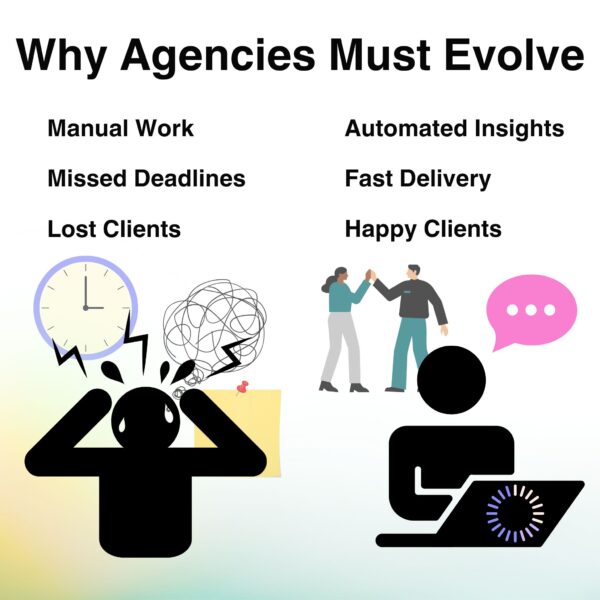
Core Categories of AI Tools for Agencies
Let’s break down what -agencies adopting AI- actually means in practice. Here are the workhorses making a real difference right now:
Marketing & Advertising
- Video Generation: Synthesia turns a script into a polished video in minutes.
I once saw a team land a last-minute pitch by dropping a client’s talking points into Synthesia at 10 p.m., and waking up to a ready-to-go video. - Design: Canva Magic Studio, GPT-4o, and Looka give designers a head start, and hand non-designers the power to create social graphics that don’t look like clipart.
- Ad Creative: AdCreative.ai analyzes what works and churns out fresh ad variations—no more guesswork.
- Email/CRM: HubSpot AI and Fyxer automate tedious outreach and keep leads from slipping through the crack.
- Content Ops: AirOps manages deadlines, briefs, and feedback loops so your team can focus on what they do best.
- Presentations: Aurora Slides (for creative agencies) and Aurora Slides (for consultants) transform messy notes and research into polished, on-brand decks in minutes.
| Tool | What it Does | Best For |
|---|---|---|
| Synthesia | AI video creation | Social/video teams |
| Canva Magic Studio | Fast design, templates | Design + content |
| AdCreative.ai | Automated ad creatives | Paid media/ads |
| HubSpot AI | Email, CRM automation | Client comms |
| AirOps | Ops, workflow automation | Project managers |
| Aurora Slides | AI-powered presentations from any content | Creative agencies, consultants, anyone needing fast, clear, beautiful decks |
Creative Agencies
Agentic AI is changing the game—think HighLevel’s Conversation AI or Voice AI, where bots handle leads and client questions 24/7. But when it comes to making your agency look brilliant in client meetings and pitches, Aurora Slides is the secret weapon.
Instead of wrestling with scattered notes, brainstorms, and last-minute changes, you just drop everything—ideas, bullet points, call transcripts—into Aurora Slides. The AI instantly organizes your content into a clear, on-brand story, applying designer-grade templates automatically. Even if design isn’t your thing, your decks will always look sharp and professional, ready for client eyes in minutes.
Need to tweak a slide, change the tone, or pivot your presentation for a new audience? Just “chat” with Aurora Slides to make edits or switch layouts on the fly. Collaboration is seamless, with sharing, live editing, and permission controls built in—perfect for fast-paced agency life.
Aurora Slides Key Features for Creatives:
- Instantly turn raw notes into compelling stories
- World-class design templates, no designer required
- Real-time chat-based editing and layout changes
- Seamless sharing and collaboration for teams
Check out this article to learn more about client meeting strategies
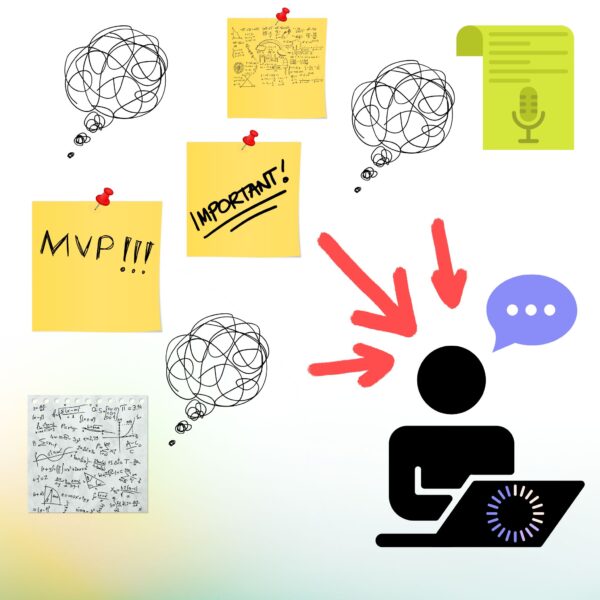
PR Agencies
Media monitoring and press release optimization have gone from manual to magic with tools like Prowly, Meltwater, Signal AI, and Cision PR AI.
After implementing Signal AI, a midsize agency reported a 25% jump in media pickups, simply because their outreach was smarter and more targeted.
Consulting Firms
Consultancies are using McKinsey QuantumBlack to be able to accelerate growth while having a competitive advantage.. AlphaSense, Olive, Zapier AI, and Tableau AI also help to automate research, build dashboards, and draft client proposals. But when it comes to turning complex findings into clear, actionable presentations, Aurora Slides is a total game-changer for consultants.
Instead of spending hours assembling slides, you can drop in research, notes, or call transcripts—Aurora Slides’ AI quickly structures your deck, suggests visuals, and tailors the flow for your target audience. It’s a huge time-saver, and every deck looks polished and client-ready.
Need to update your slides for a different client, add sensitive controls, or collaborate securely with your team? Aurora Slides makes it easy, with permission settings and real-time editing.
Aurora Slides Key Features for Consultants:
- Intelligent mapping from raw data to visual narrative
- Effortless slide reformatting for different audiences
- Collaboration and permission controls for client confidentiality
- Real-time feedback and notifications to keep teams aligned
This other article I recommend to get a deep dive on AI tools for consultants.
The Evolving Demands on Agencies
The bar is higher than ever. According to Zendesk, 61% of consumers now expect personalized service in every AI-driven interaction. I’ve seen agencies lose clients because they took too long to surface campaign results—or even just to answer questions. Meanwhile, agencies with AI-powered reporting can show up with real-time insights and proactive recommendations, and clients love it.
Then, there’s the new competitive landscape… constantly evolving. The operational speed of AI-first agencies sets a new benchmark. Where a traditional agency might take weeks to analyze campaign performance and adjust strategies, AI-powered systems can make these adjustments within hours or even minutes. This unparalleled speed and efficiency are becoming non-negotiable competitive advantages. Furthermore, AI’s increasing accessibility is enabling brands to manage more marketing functions internally, leading to concerns among
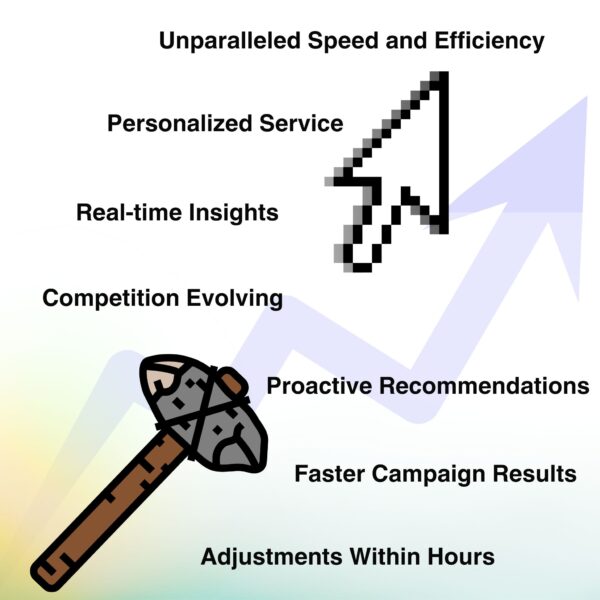
Overcoming Challenges: Data, Talent, and Change Management
Let’s get real: integrating AI isn’t plug-and-play. Data quality, legacy systems, privacy concerns, and team resistance are all very real hurdles. One of the most significant barriers is cultural resistance, with employees often perceiving AI as a direct threat to their jobs.
Leaders are facing their own challenges as well. As Admatic recently noted:
“The authority of experience is being challenged. Leaders who built careers on intuition now face AI-driven insights that demand trust in data over gut instinct.”
It would be comforting to think job structures will stay the same, but that’s simply not realistic. So, what’s the solution? Agencies need to prioritize upskilling, transparent communication, and ongoing change management to ensure everyone—from junior staff to senior leadership—can thrive in an AI-powered environment.
Case in point:
A 2024 BCG study found that 70% of AI adoption challenges aren’t technical—they come down to people and processes.
How roles are evolving:
| Old Role | New Role |
|---|---|
| Manual analyst | Data/AI strategist |
| Project manager | Automation workflow designer |
| Junior creative | AI content curator/editor |
| Intuitive leader | Data-driven decision maker |
The bottom line: Succeeding with AI isn’t just about buying the best software—it’s about investing in your people, evolving leadership mindsets, and building a culture that’s ready for change.
New Business Models & Revenue Streams
AI doesn’t just save time—it unlocks entirely new ways to generate business. Agencies are spinning up SaaS products, launching subscription-based services, and creating hybrid models with recurring revenue at their core.
For example, as highlighted in “The 6 Best AI Agency Niches to Make $50K/mo (Data-Backed)”:
- Productized AI Services Over Traditional Agencies:
Rather than offering generic AI automation as a service (which often results in one-off, project-based revenue), top agencies are focusing on highly specific, productized deliverables using AI. For instance, instead of building custom automations for each client, an agency might offer monthly packages for AI-powered ad creative, reporting, or lead generation—ensuring stable, recurring income and easier scaling. - Med Spa Marketing as a Niche Retainer Model:
Agencies are building out specialized, AI-driven marketing packages for high-value verticals like med spas. These service bundles include automated ad creation for Facebook/Instagram, Google Maps optimization, and AI-powered reporting dashboards—all priced as a recurring monthly retainer. This approach leverages AI for creative production and campaign management, making it possible to serve more clients with less manual labor . - AI-Powered Content for E-Commerce Brands:
Another new model is creating AI-generated ad content (images, videos, copy) for beauty and e-commerce brands. Agencies use AI tools to rapidly produce and test large volumes of creative, offering subscription packages (e.g., “20 new ads per month for $3k–$5k”). This lets agencies move beyond billing by the hour and instead charge for deliverables and performance. - Social Media Management for Coaches and Influencers:
Agencies are using AI to automate daily content generation, scheduling, and analytics for nutrition coaches, fitness trainers, or other micro-influencers. By bundling these services into monthly plans, agencies create reliable, scalable income streams and free up staff to focus on strategy. - AI-Driven Data Analytics Agencies:
Some agencies are launching “unlimited analytics” services for SMBs—offering AI-powered dashboards, ad-hoc data analysis, and reporting for a flat monthly fee. This shifts the agency from a project-based consulting model to a high-margin, subscription-based business.
These models have key things in common:
- They focus on recurring revenue, not one-off projects.
- They leverage AI to deliver consistent, scalable results.
- They differentiate by targeting specific verticals or business outcomes.
Watch the full video here:
ROI and Tangible Benefits
Let’s talk numbers. Companies using AI agents are seeing up to 30% higher ROI and 80% cost reductions. In the creative world, BCG reports that agencies using generative AI tools cut production costs by 20–30%.
| Metric | Before AI | After AI |
|---|---|---|
| Campaign ROI | 3.5x | 4.6x |
| Time to delivery | 10 days | 2 days |
| Cost per asset | $500 | $300 |
Best Practices & Next Steps
Ready to put AI to work? Here’s how to start:
- Audit your team’s time—where are you losing the most hours?
- Shortlist AI tools that directly target those bottlenecks.
- Run a pilot with a small client or internal project.
- Invest in upskilling—AI is only as smart as the team using it.
- Set clear KPIs—measure and share wins (and lessons learned).
Conclusion & Key Takeaways
AI isn’t going to replace what makes your agency special—but it will expose anything that’s slow, sloppy, or stuck in the past. And it will make your agency look outdated vs the AI-enhanced work other agencies will be showing to your potential clients. The agencies that invest in AI now are the ones your clients will call next year. So, are you ready to evolve? Do you have as part of your strategy to research the best AI tools for agencies at the moment?
Frequently Asked Questions (FAQs)
What are the best AI tools for agencies in 2024?
A: Try Synthesia (video), Canva Magic Studio (design), HubSpot AI (CRM), and Aurora Slides (presentations).
How do you measure ROI from AI?
A: Track hours saved, cost per deliverable, client retention, and campaign results before/after adoption.
What are the biggest risks?
A: Data privacy, quality control, and getting buy-in from your team. Counter these with clear policies, training, and transparency.
All-in-one platforms or specialized tools?
A: All-in-one is great for smaller teams. Larger agencies usually need best-in-class, specialized tools for different departments.
What makes Aurora Slides different from other AI presentation tools?
A: Aurora Slides stands out by instantly transforming any source—notes, transcripts, bullet points—into a polished, on-brand presentation. Unlike basic slide generators, it uses intelligent content mapping, designer-grade templates, and conversational editing, so you can refine slides just by chatting with the AI. It’s built for speed, collaboration, and real-world agency workflows.
Can I use Aurora Slides if I have no design or tech background?
A: Yes! Aurora Slides was designed so anyone can create beautiful, professional decks in minutes. If you are in need of AI Tools for Digital Marketing Agency, it’s also a good option. Here’s why: you don’t need design skills or technical know-how—just drop in your content, choose a template, and let the AI do the heavy lifting. You can even edit and reformat slides with simple instructions, making it perfect for both creative pros and client-facing consultants.
